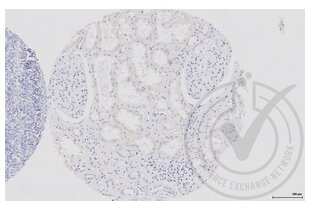AQP2 Antikörper (AA 171-271)
-
- Target Alle AQP2 Antikörper anzeigen
- AQP2 (Aquaporin 2 (Collecting Duct) (AQP2))
-
Bindungsspezifität
- AA 171-271
-
Reaktivität
- Human, Ratte, Maus
-
Wirt
- Kaninchen
-
Klonalität
- Polyklonal
-
Konjugat
- Dieser AQP2 Antikörper ist unkonjugiert
-
Applikation
- Western Blotting (WB), ELISA, Immunofluorescence (Paraffin-embedded Sections) (IF (p)), Immunofluorescence (Cultured Cells) (IF (cc)), Immunohistochemistry (Paraffin-embedded Sections) (IHC (p)), Immunocytochemistry (ICC), Flow Cytometry (FACS), Immunohistochemistry (Frozen Sections) (IHC (fro))
- Kreuzreaktivität
- Human, Maus, Ratte
- Homologie
- Dog
- Aufreinigung
- Purified by Protein A.
- Immunogen
- KLH conjugated synthetic peptide derived from human AQP2.
- Isotyp
- IgG
-
-
- Applikationshinweise
-
WB 1:300-5000
ELISA 1:500-1000
FCM 1:20-100
IHC-P 1:200-400
IHC-F 1:100-500
IF(IHC-P) 1:50-200
IF(IHC-F) 1:50-200
IF(ICC) 1:50-200
ICC 1:100-500 - Beschränkungen
- Nur für Forschungszwecke einsetzbar
-
- by
- Immunohistochemistry Core, NYU Langone
- No.
- #029457
- Datum
- 16.01.2014
- Antigen
- Chargennummer
- 999994W
- Validierte Anwendung
- Immunohistochemistry
- Positivkontrolle
- - Human kidney tubules - Human breast ductal epithelium
- Negativkontrolle
- - Human kidney glomeruli and stromal tissue - Human breast mesenchymal tissue
- Bewertung
- Strong signal was observed in positive control tissues and not in negative control tissues.
- Primärantikörper
- Antibody: Aquaporin 2
- Catalog number: ABIN707576
- Batch number: 999994W
- Sekundärantikörper
- Antibody: Biotinylated goat anti-rabbit/anti-mouse (Kit)
- Lot number: D05923BA
- Full Protocol
- Immunohistochemistry was performed on a Ventana NexES automated platform, instrument manufacturer specific reagents are italicized.
- 1. Slides were preheated in convection oven at 60°C for 30 min
- 2. Deparaffinization procedure: - 3 changes of Xylene, 5 min each - 3 changes of 100% Ethanol, 3 min each - 3 changes of 95% Ethanol, 3 min each - Rinsed in distilled water, 3 changes
- 3. Heat retrieval procedure - Slides retrieved in 10.0 mM Citrate, pH6.0 in a 1000W microwave oven (~100°C) for 15 min. - Slides were allowed to cool (in citrate) for 30 min. - Slides were washed x 3 in Distilled water
- 4. NexES instrument procedure, iVIEW DAB paraffin protocol (*abridged*): - Slide chamber warmed to 37°C
- 5. Slides rinsed with reaction buffer x3
- 6. *iVIEW Inhibitor (H2O2)* applied and incubated for 4 min
- 7. Slides rinsed with *reaction buffer*
- 8. Antibody Application - Primary antibody diluted 1:250 in PBS (100 µL applied/slide) - Ventana Isotype control applied neat - Slides Incubated overnight at room temperature (~12 hours ~25°C)
- 9. Slides rinsed with *reaction buffer* x3
- 10. *iVIEW Biotinylated IgG* applied and incubated for 8 min
- 11. Slides rinsed with *reaction buffer*
- 12. *iVIEW Streptavidin-Horseradish Peroxidase* applied and incubated for 8 min
- 13. Slides rinsed with *reaction buffer*
- 14. *iVIEW DAB/H2O2* applied and incubated for 8 min
- 15. Slides rinsed with *reaction buffer*
- 16. *iVIEW Copper* applied and incubated for 4 min
- 17. Slides rinsed with *reaction buffer*
- 18. Slides washed in Dawn Detergent/tap water
- 19. Counterstain Procedure - Hematoxylin (Leica 560 MX) 30 seconds - Slides washed in tap water, 1 min - Decolorized (10% Acetic Acid in 70% ethanol), 1 min - Slides washed in tap water, 1 min - Bluing (Austin Clear Ammonia), 1 min - Slides washed in tap water, 1 min
- 20. Dehydration/coverslipping procedure: - 3 changes of 95% Ethanol, 3 min each - 3 changes of 100% Ethanol, 3 min each - 3 changes of Xylene, 5 min each - Mounted with Permount
- 21. Imaging: Leica SCN 400F Whole Slide Scanner with Digital Image Hub and Leica Slidepath software
- Anmerkungen
- Deviations from protocol/procedure supplied by manufacturer.
- Step 1: Heated tissue 60°C for 30 minutes; manufacturer heats for 45 minutes.
- Step 2: No ethanol wash was performed during deparaffinization; manufacturer includes 1 wash of 80% ethanol for 3 minutes.
- Step 3.1: Slides heated for 15 minutes; manufacturer provides a range of 15-20 minutes.
- Step 3.2: Slides cooled for 30 minutes; manufacturer cools for 20 minutes.
- Step 4: Italicized reagents and incubation time are fixed instrument parameters.
- Step 5: Secondary species-specific serum block not used; manufacturer blocks with 5% normal goat serum for 2 hours.
Validierung #029457 (Immunohistochemistry)![Erfolgreich validiert 'Independent Validation' Siegel]()
![Erfolgreich validiert 'Independent Validation' Siegel]() ValidierungsbilderProtokoll
ValidierungsbilderProtokoll -
- Format
- Liquid
- Konzentration
- 1 μg/μL
- Buffer
- 0.01M TBS( pH 7.4) with 1 % BSA, 0.02 % Proclin300 and 50 % Glycerol.
- Konservierungsmittel
- ProClin
- Vorsichtsmaßnahmen
- This product contains ProClin: a POISONOUS AND HAZARDOUS SUBSTANCE, which should be handled by trained staff only.
- Lagerung
- 4 °C,-20 °C
- Informationen zur Lagerung
- Shipped at 4°C. Store at -20°C for one year. Avoid repeated freeze/thaw cycles.
- Haltbarkeit
- 12 months
-
-
: "Endocycle-related tubular cell hypertrophy and progenitor proliferation recover renal function after acute kidney injury. ..." in: Nature communications, Vol. 9, Issue 1, pp. 1344, (2018) (PubMed).
-
: "Endocycle-related tubular cell hypertrophy and progenitor proliferation recover renal function after acute kidney injury. ..." in: Nature communications, Vol. 9, Issue 1, pp. 1344, (2018) (PubMed).
-
- Target
- AQP2 (Aquaporin 2 (Collecting Duct) (AQP2))
- Andere Bezeichnung
- AQP2 (AQP2 Produkte)
- Hintergrund
-
Synonyms: AQP-CD, WCH-CD, Aquaporin-2, AQP-2, ADH water channel, Aquaporin-CD, Collecting duct water channel protein, Water channel protein for renal collecting duct, AQP2
Background: Forms a water-specific channel that provides the plasma membranes of renal collecting duct with high permeability to water, thereby permitting water to move in the direction of an osmotic gradient.
- Gen-ID
- 359
- UniProt
- P41181
- Pathways
- Response to Water Deprivation
-







 (2 Referenzen)
(2 Referenzen) (1 Validierung)
(1 Validierung)



